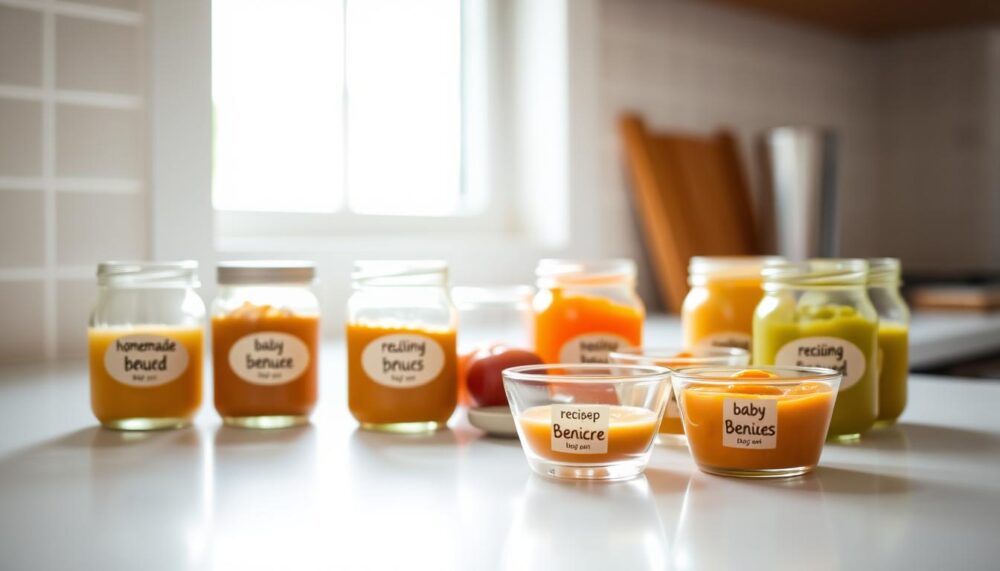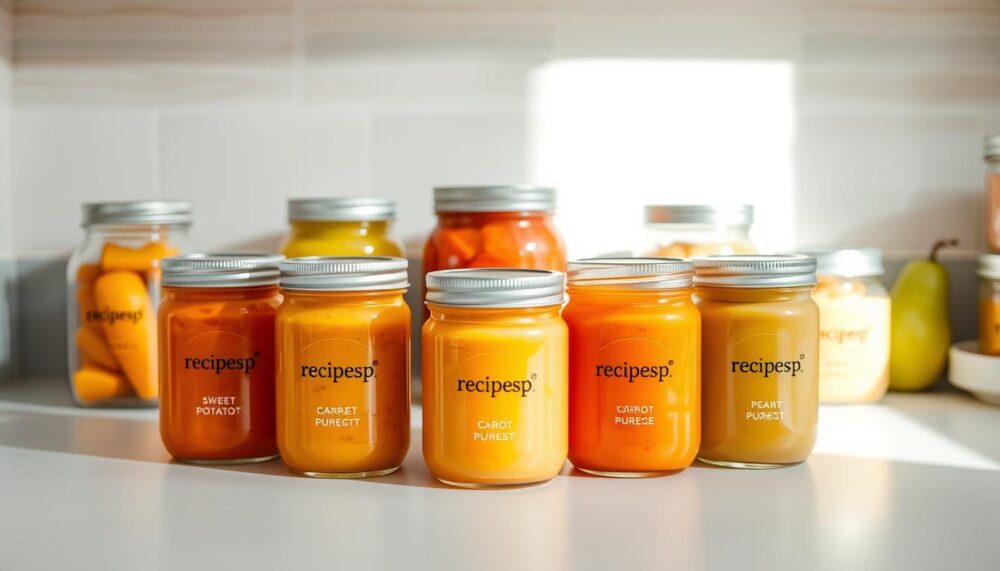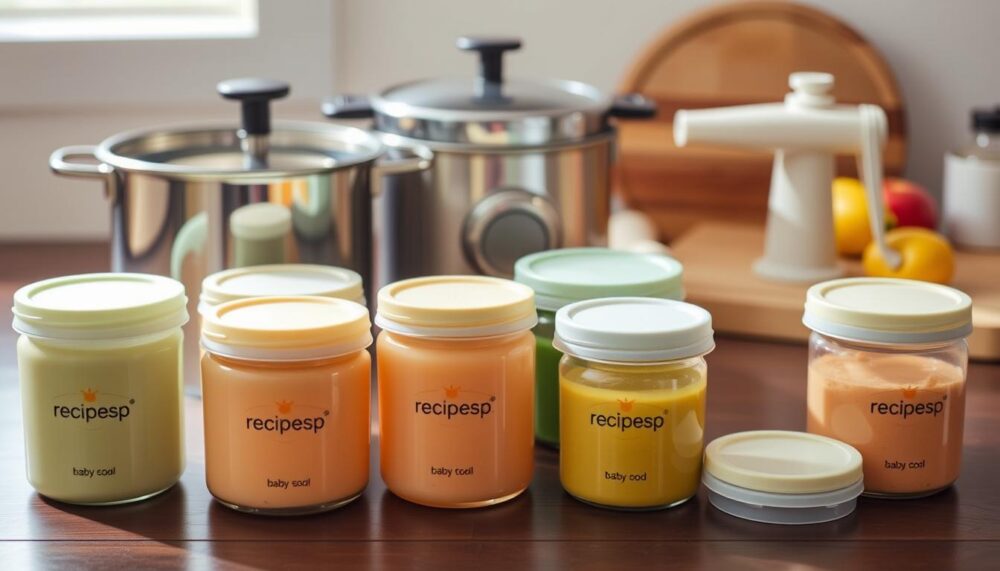
how long can homemade baby food stay in the fridge? As a parent, keeping your baby’s food fresh and safe is key. Many wonder how long homemade baby food can stay in the fridge. It’s important to store it right to keep it good and safe.
Refrigerating homemade baby food helps it stay fresh longer. But, you must store it carefully to avoid spoilage and sickness.
Knowing how to store homemade baby food is crucial for your baby’s health. To store safely, follow the right steps. This way, you can prepare meals ahead of time.
Refrigerating is a good method, but remember to follow storage times. This ensures the food stays fresh and safe for your baby.
Key Takeaways
- Proper storage is crucial to maintain the quality and safety of homemade baby food
- Refrigerating homemade baby food is an effective way to keep it fresh
- Storing homemade baby food requires careful consideration to prevent spoilage and foodborne illnesses
- Understanding the basics of storing homemade baby food is vital to keep your baby healthy
- Following proper guidelines and techniques is essential for safe storage
Understanding Baby Food Storage Basics
Storing baby food right is key to keep it nutritious and safe. Keeping homemade baby food fresh needs careful steps and following baby food storage guidelines. It’s important to think about the food type, how it’s made, and the container used. Preserving homemade baby food is easy with the right storage methods.
For baby food quality and safety, following general food safety guidelines is crucial. This means keeping things clean, using clean tools, and storing food at the right temperature. The best storage temperature for baby food is between 32°F and 40°F (0°C and 4°C).
Some important things to remember for storing baby food include:
- Using airtight, shallow containers to prevent bacterial growth
- Labeling and dating containers to ensure older food is consumed first
- Storing food in the refrigerator at a consistent temperature
- Avoiding cross-contamination with other foods and utensils

By sticking to these easy tips and keeping homemade baby food fresh, parents can make sure their baby’s food is safe, healthy, and full of nutrients. Always check the food for any signs of spoilage before giving it to your baby.
How Long Can Homemade Baby Food Stay in the Fridge
Storing homemade baby food right is key to keeping it fresh and safe. Homemade baby food can stay good in the fridge for 3 to 5 days. This depends on the food type and how it’s stored. Always follow baby food refrigeration tips to keep the food quality and safety up.
Here are things to think about when figuring out how long baby food lasts:
- Type of food: Pureed fruits and veggies usually don’t last as long as solid foods or mixes.
- Storage conditions: The fridge’s temperature and how you handle the food matter a lot. Keep baby food in airtight containers at 40°F (4°C) or colder.
- Packaging: The container you use can also affect how long the food lasts. Choose containers made for baby food that are safe and non-toxic.

By following these tips and baby food refrigeration tips, you can make your homemade baby food last longer. This way, it stays fresh and safe for your baby. Always check the food for spoilage before giving it to your baby.
Storage Times for Different Types of Baby Food
Storing baby purees right is key. The type of food and its acidity level matter. Fruit purees are more acidic than veggie ones, affecting their shelf life. Knowing this helps keep baby food safe and fresh.
Using airtight containers is a good way to keep baby food quality up. But, different foods have different storage times. Let’s look at how long you can store different baby foods:
Fruit Purees
Fruit purees like applesauce or mango last 3-5 days in the fridge. Always check for spoilage signs before feeding them to your baby.

Vegetable Purees
Vegetable purees, like carrots or sweet potatoes, can last 5-7 days in the fridge. Always label and date containers to use the oldest first and avoid expired food.
Freezing is also a good way to store baby food. Frozen food can last 3-6 months, depending on the food and freezer conditions. Use airtight containers or freezer bags to avoid freezer burn and keep food quality high.
Proper Storage Containers and Equipment
Using the right baby food storage containers is key. Airtight containers keep food fresh and safe. Choose containers made for baby food, as they are safe and non-toxic.
It’s also vital to refrigerate homemade baby food. Store it in the fridge at 40°F (4°C) or below. This stops bacteria from growing and keeps food fresh longer. Freezer-safe bags are great for storing, as they can be labeled and dated.
Brands like Gerber and Philips Avent offer good storage options. They make storing and serving baby food easy. When picking containers, think about these things:
- Material: Choose safe, non-toxic materials.
- Size: Pick the right size for your baby.
- Ease of use: Look for containers that are easy to open and close.

Right storage helps keep baby food fresh and safe. Always follow food safety rules when storing and serving. If you’re unsure, talk to your pediatrician.
Signs Your Baby Food Has Gone Bad
Keeping homemade baby food fresh is key. You need to check it often to make sure it’s safe. Preserving it well means watching for signs it’s gone bad.
Baby food can spoil even if stored right. This can be because of contamination or bad container sealing.
- Off smells or slimy texture
- Mold or yeast growth
- Slime or fermentation
Trust your gut if the food looks, smells, or tastes wrong. It’s better to throw it away. Remember, keeping baby food fresh is not just about storage. It’s also about checking it often for spoilage to keep your baby safe.
Best Practices for Preparing Baby Food for Storage
When making baby food, it’s important to follow baby food storage guidelines closely. This ensures the food is safe and stays fresh. The homemade baby food shelf life changes based on the food type and how it’s stored.
To keep homemade baby food fresh, follow good hygiene. This means washing your hands well, cleaning all tools and containers, and using tight containers. This helps stop bad bacteria from getting in.
Here are some tips to remember:
- Label and date containers so you can tell what’s in them and when they were made
- Use containers that are airtight and BPA-free to keep food fresh and safe
- Keep food in the fridge at a cold temperature below 40°F (4 c)
- Freeze food right after you make it to keep nutrients in and stop it from going bad
By sticking to these tips, parents can make sure their baby’s food is stored right. This helps keep the homemade baby food shelf life long. For more on baby food storage guidelines, talk to a pediatrician or a healthcare expert.
Freezing vs. Refrigeration: Making the Right Choice
Parents have two main choices for storing homemade baby food: freezing and refrigerating. Each method has its own pros and cons. The best choice depends on the food type, storage space, and personal preference. Storing homemade baby food needs careful thought to keep it safe and nutritious for the baby.
Refrigerating is good for short-term storage but not for long. Freezing is better for longer storage, but you must follow freezer guidelines to keep food quality.
Freezer Storage Guidelines
To store food safely in the freezer, follow these steps:
- Use airtight containers or freezer bags to prevent freezer burn and contamination.
- Label the containers with the date and contents to ensure easy identification.
- Store the containers in the freezer at 0°F (-18°C) or below.
Thawing Methods
When thawing frozen baby food, use safe methods to avoid bacterial growth. Safe thawing includes refrigerating overnight or thawing in cold water.
Refreezing Rules
Refreezing baby food is not always safe. It can lower food quality and safety. But, if thawed safely and handled right, it can be refrozen. Refrigerating homemade baby food after thawing is not safe, as it can cause bacterial growth and contamination.
Common Storage Mistakes to Avoid
Storing homemade baby food right is key. One big mistake is not keeping the food at the right temperature. This can make the food go bad too soon. To avoid this, use baby food refrigeration tips like storing it in airtight containers at a steady fridge temperature.
Another error is not using the right packaging. This can lead to contamination or spoilage. Use clean, airtight containers and mark them with the date and what’s inside. Also, not washing your hands before touching the food can cause contamination.
- Always check the temperature of the refrigerator and freezer to ensure it’s within the safe range.
- Use airtight, clean containers to store the food.
- Label the containers with the date and contents.
- Wash hands before handling the food.
By following thesebaby food refrigeration tipsand being careful abouthomemade baby food expiration, parents can keep their baby’s food safe and fresh.
Tips for Extending Shelf Life
Keeping homemade baby food fresh is important. There are several techniques to help. Preparation techniques involve careful handling and processing. This prevents contamination and spoilage.
Another key factor is storage methods. Using airtight containers, labeling, and dating food is crucial. Storing it in the fridge or freezer at the right temperature is also important. This stops bacteria and other harmful microorganisms from growing.
Effective Storage Techniques
- Use airtight, BPA-free containers to prevent contamination
- Label and date the food with the contents and storage date
- Store food in the refrigerator at a temperature of 40°F (4°C) or below
- Consider freezing food for longer-term storage, using airtight containers or freezer bags
Temperature control is key to keeping food fresh. Keeping the fridge at a consistent temperature is important. Using the freezer for longer storage also helps prevent bacteria growth.
Temperature Control Tips
Regularly check the refrigerator temperature to ensure it remains at or below 40°F (4°C)
Use a food thermometer to check the internal temperature of the food, specially when reheating
By following these tips, parents can keep homemade baby food fresh. This is important for keeping it nutritious and safe for longer.
Safe Handling and Serving Guidelines
Handling and serving baby food safely is very important. The American Academy of Pediatrics says parents should wash their hands before making and serving food. This helps prevent germs and keeps the baby healthy.
Here are some key guidelines for safe handling and serving of baby food:
- Check the baby food storage guidelines to ensure that the food is stored at the correct temperature and for the recommended amount of time.
- Always use clean utensils and equipment when preparing and serving baby food.
- Be aware of the homemade baby food shelf life to avoid serving spoiled or expired food to the baby.
Parents should also watch for signs of spoilage. Throw away any food that smells bad, is slimy, or has mold. By following these steps, parents can keep their baby’s food safe and healthy.
Remember, keeping baby food safe is key to their health. By knowing and following these guidelines, parents can give their baby a healthy start.
Food Safety Myths and Facts
Storing homemade baby food safely is key. Many myths can lead to bad food handling. It’s important to know the truth to keep your baby healthy.
One myth is that refrigerating baby food kills all bacteria. But it’s not true. Refrigeration slows down bacteria growth. Still, it’s vital to follow the right storage rules to avoid contamination.
Some think freezing is the best way to keep baby food fresh. But it’s not always right. Freezing can kill some bacteria, but not all. It’s crucial to follow evidence-based storage rules.
Refrigerating baby food at a temperature below 40°F (4°C) is best. This stops bacteria from growing and keeps food safe for your baby.
- Myth: You can store homemade baby food at room temperature for several hours.
- Myth: Freezing homemade baby food will kill all bacteria.
- Myth: You can refreeze thawed homemade baby food without any risks.
Knowing these myths and following the right storage and refrigeration guidelines is crucial. This ensures your baby’s safety and health.
Conclusion
As we wrap up this article, it’s key to stress the need for proper baby food storage. We’ve talked about the basics and how to spot spoiled food. These tips are vital for your baby’s health and safety.
By storing baby food the right way, you ensure your child eats fresh, healthy meals. This keeps them safe from harmful stuff.
Storing baby food right is a small but important step. It helps your child get a great start in life. Now, you know how to make smart choices for your baby’s diet. You can be sure their meals are handled with care.
FAQ
How long can homemade baby food stay in the fridge?
Homemade baby food’s fridge life varies by ingredients and storage. Purees usually last 3-5 days. Solid foods and mixes might last 2-3 days.
What are the general food safety guidelines for storing homemade baby food?
Keep baby food safe by storing it at 40°F or below. Use clean hands and utensils. Avoid cross-contamination. Proper packaging and labels are key.
What temperature should homemade baby food be stored at?
Store baby food in the fridge at 40°F or below. This stops harmful bacteria and keeps food fresh and safe.
How long can fruit purees be stored in the fridge?
Fruit purees last 3-5 days in the fridge. The fruit’s acidity and storage method affect this time.
How long can vegetable purees be stored in the fridge?
Vegetable purees last 2-3 days. They spoil faster than fruit purees because of their lower acidity.
How long can meat-based baby foods be stored in the fridge?
Meat-based foods last 2-3 days in the fridge. Keep them at the right temperature to prevent bacterial growth.
How long can mixed ingredient baby food preparations be stored in the fridge?
Mixed foods last 2-3 days. The exact time depends on the ingredients and their moisture and acidity.
What are the best storage containers and equipment for homemade baby food?
Use airtight, food-grade containers or freezer-safe bags. Avoid harmful chemicals. Keep your fridge at 40°F or below.
What are some signs that homemade baby food has gone bad?
Bad signs include mold, off smells, or texture changes. If you see these, throw the food away to avoid illness.
What are some best practices for preparing homemade baby food for storage?
Wash your hands and sanitize surfaces. Use clean packaging and control the temperature. These steps keep food safe and quality high.
What are the advantages and disadvantages of freezing vs. refrigerating homemade baby food?
Freezing extends shelf life but requires careful thawing. Refrigeration keeps food fresh for short periods. Both methods need attention to temperature and safety.
What are some common storage mistakes to avoid when storing homemade baby food?
Avoid wrong temperatures, bad packaging, and poor hygiene. Follow guidelines, use proper containers, and keep storage clean.
What are some tips for extending the shelf life of homemade baby food?
Use blanching or steaming, choose the right storage, and control temperatures. These steps help keep food fresh longer.
What are some safe handling and serving guidelines for homemade baby food?
Wash hands, use clean utensils, and avoid cross-contamination. Control temperatures and portion sizes for safety and quality.
What are some common myths and facts about storing homemade baby food?
Myths say you can store food at room temperature or refreeze thawed food. But, proper temperature control, packaging, and times are key.